service indicator HONDA CIVIC COUPE 1999 Owners Manual
[x] Cancel search | Manufacturer: HONDA, Model Year: 1999, Model line: CIVIC COUPE, Model: HONDA CIVIC COUPE 1999Pages: 269, PDF Size: 2.42 MB
Page 6 of 269
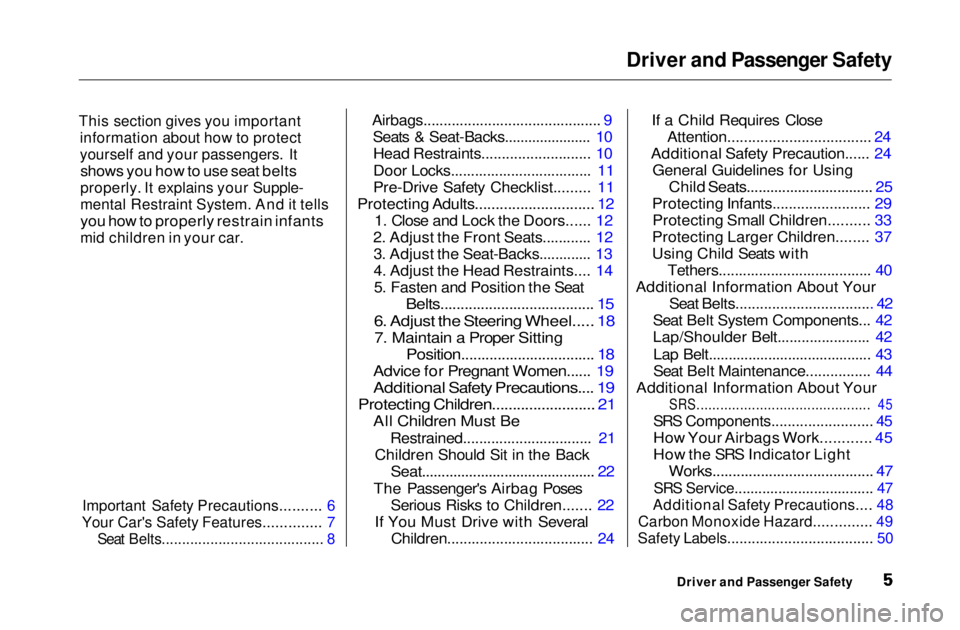
Driver and Passenger Safety
This section gives you important
information about how to protect
yourself and your passengers. It
shows you how to use seat belts
properly. It explains your Supple-
mental Restraint System. And it tells
you how to properly restrain infants
mid children in your car.
Important Safety Precautions.......... 6
Your Car's Safety Features.............. 7
Seat Belts........................................ 8
Airbags............................................ 9
Seats & Seat-Backs...................... 10Head Restraints........................... 10
Door Locks................................... 11
Pre-Drive Safety Checklist......... 11
Protecting Adults............................. 12
1. Close and Lock the Doors...... 12
2. Adjust the Front Seats............ 12 3. Adjust the Seat-Backs............. 13
4. Adjust the Head Restraints.... 145. Fasten and Position the Seat
Belts...................................... 15
6. Adjust the Steering Wheel..... 18
7. Maintain a Proper Sitting
Position................................. 18
Advice for Pregnant Women...... 19
Additional Safety Precautions.... 19
Protecting Children......................... 21
All Children Must Be
Restrained................................ 21
Children Should Sit in the Back
Seat............................................ 22
The Passenger's Airbag Poses Serious Risks to Children....... 22
If You Must Drive with Several Children.................................... 24 If a Child Requires Close
Attention................................... 24
Additional Safety Precaution...... 24 General Guidelines for Using
Child Seats................................ 25
Protecting Infants........................ 29 Protecting Small Children.......... 33
Protecting Larger Children........ 37
Using Child Seats with Tethers...................................... 40
Additional Information About Your
Seat Belts.................................. 42
Seat Belt System Components... 42
Lap/Shoulder Belt....................... 42
Lap Belt......................................... 43
Seat Belt Maintenance................ 44
Additional Information About Your
SRS............................................ 45
SRS Components......................... 45
How Your Airbags Work............ 45
How the SRS Indicator Light
Works........................................ 47
SRS Service................................... 47
Additional Safety Precautions.... 48
Carbon Monoxide Hazard.............. 49
Safety Labels.................................... 50
Driver and Passenger SafetyMain Menu s t
Page 48 of 269
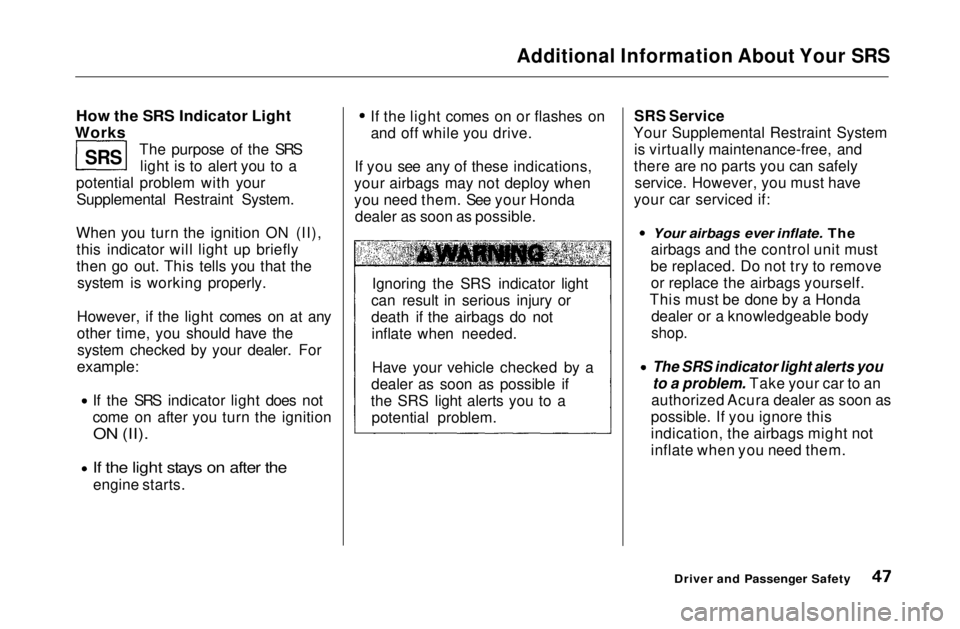
Additional Information About Your SRS
How the SRS Indicator Light
Works
The purpose of the SRSlight is to alert you to a
potential problem with your Supplemental Restraint System.
When you turn the ignition ON (II), this indicator will light up briefly
then go out. This tells you that the system is working properly.
However, if the light comes on at any
other time, you should have the system checked by your dealer. For
example:
If the SRS indicator light does not
come on after you turn the ignition
ON (II). If the light stays on after the
engine starts. If the light comes on or flashes on
and off while you drive.
If you see any of these indications,
your airbags may not deploy when
you need them. See your Honda dealer as soon as possible. SRS Service
Your Supplemental Restraint System is virtually maintenance-free, and
there are no parts you can safely service. However, you must have
your car serviced if:
Your airbags ever inflate. The
airbags and the control unit must
be replaced. Do not try to remove or replace the airbags yourself.
This must be done by a Honda dealer or a knowledgeable body
shop.
The SRS indicator light alerts you
to a problem. Take your car to an
authorized Acura dealer as soon as
possible. If you ignore this
indication, the airbags might not
inflate when you need them.
Driver and Passenger Safety
SRS
Ignoring the SRS indicator light
can result in serious injury or
death if the airbags do not inflate when needed.
Have your vehicle checked by a
dealer as soon as possible if
the SRS light alerts you to a potential problem.Main Menu Table of Contents s t
Page 124 of 269
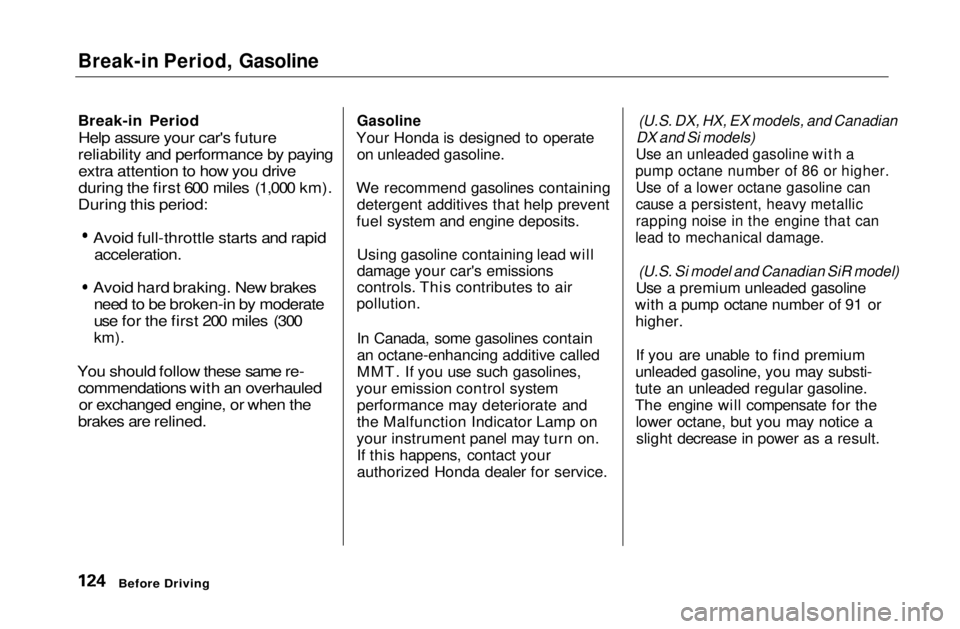
Break-in Period, Gasoline
Break-in Period
Help assure your car's future
reliability and performance by paying extra attention to how you drive
during the first 600 miles (1,000 km).
During this period: Avoid full-throttle starts and rapid
acceleration.
Avoid hard braking. New brakes
need to be broken-in by moderate
use for the first 200 miles (300
km).
You should follow these same re- commendations with an overhauledor exchanged engine, or when the
brakes are relined.
Gasoline
Your Honda is designed to operate on unleaded gasoline.
We recommend gasolines containing detergent additives that help prevent
fuel system and engine deposits.
Using gasoline containing lead will
damage your car's emissions
controls. This contributes to air
pollution.
In Canada, some gasolines contain
an octane-enhancing additive called
MMT. If you use such gasolines,
your emission control system performance may deteriorate and
the Malfunction Indicator Lamp on
your instrument panel may turn on. If this happens, contact your
authorized Honda dealer for service.
(U.S. DX, HX, EX models, and Canadian
DX and Si models)
Use an unleaded gasoline with a
pump octane number of 86 or higher. Use of a lower octane gasoline can
cause a persistent, heavy metallic
rapping noise in the engine that can
lead to mechanical damage.
(U.S. Si model and Canadian SiR model)
Use a premium unleaded gasoline
with a pump octane number of 91 or higher.
If you are unable to find premium
unleaded gasoline, you may substi-
tute an unleaded regular gasoline.
The engine will compensate for the lower octane, but you may notice aslight decrease in power as a result.
Before DrivingMain Menu Table of Contents s t
Page 125 of 269
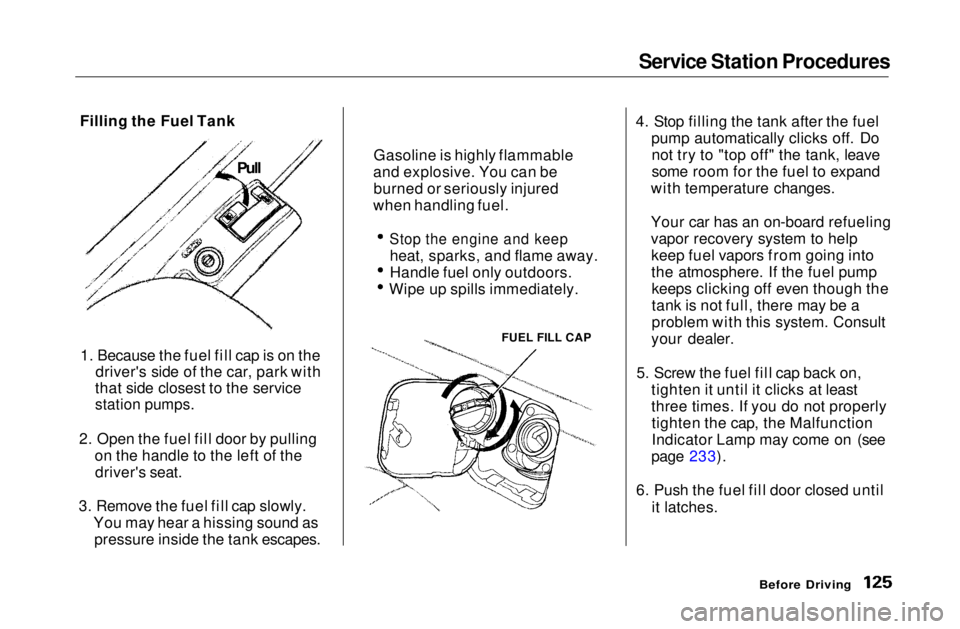
Service Station Procedures
Filling the Fuel Tank
1. Because the fuel fill cap is on the driver's side of the car, park with
that side closest to the service
station pumps.
2. Open the fuel fill door by pulling on the handle to the left of thedriver's seat.
3. Remove the fuel fill cap slowly. You may hear a hissing sound aspressure inside the tank escapes. 4. Stop filling the tank after the fuel
pump automatically clicks off. Donot try to "top off" the tank, leave
some room for the fuel to expand
with temperature changes.
Your car has an on-board refueling
vapor recovery system to help keep fuel vapors from going into
the atmosphere. If the fuel pumpkeeps clicking off even though the
tank is not full, there may be a
problem with this system. Consult
your dealer.
5. Screw the fuel fill cap back on, tighten it until it clicks at least
three times. If you do not properlytighten the cap, the Malfunction
Indicator Lamp may come on (see
page 233).
6. Push the fuel fill door closed until it latches.
Before Driving
FUEL FILL CAP
Gasoline is highly flammable
and explosive. You can be burned or seriously injured
when handling fuel.
Stop the engine and keep
heat, sparks, and flame away.
Handle fuel only outdoors. Wipe up spills immediately.
PullMain Menu Table of Contents s t
Page 231 of 269
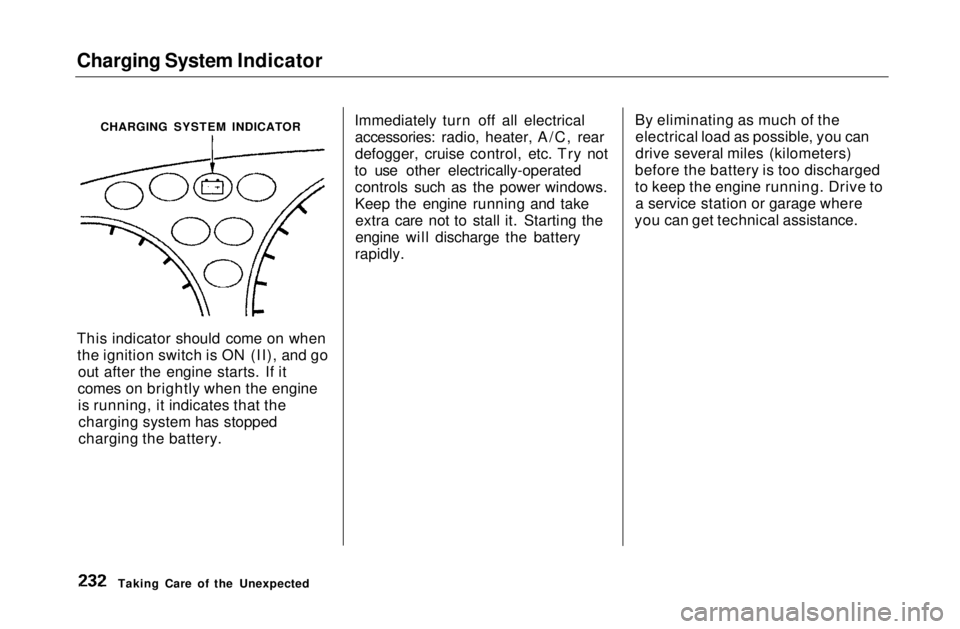
Charging System Indicator
This indicator should come on when
the ignition switch is ON (II), and go out after the engine starts. If it
comes on brightly when the engine is running, it indicates that thecharging system has stopped
charging the battery. Immediately turn off all electrical
accessories: radio, heater, A/C, rear
defogger, cruise control, etc. Try not
to use other electrically-operated controls such as the power windows.
Keep the engine running and takeextra care not to stall it. Starting the
engine will discharge the battery
rapidly. By eliminating as much of the
electrical load as possible, you can
drive several miles (kilometers)
before the battery is too discharged
to keep the engine running. Drive to a service station or garage where
you can get technical assistance.
Taking Care of the Unexpected
CHARGING SYSTEM INDICATORMain Menu Table of Contents s t
Page 233 of 269
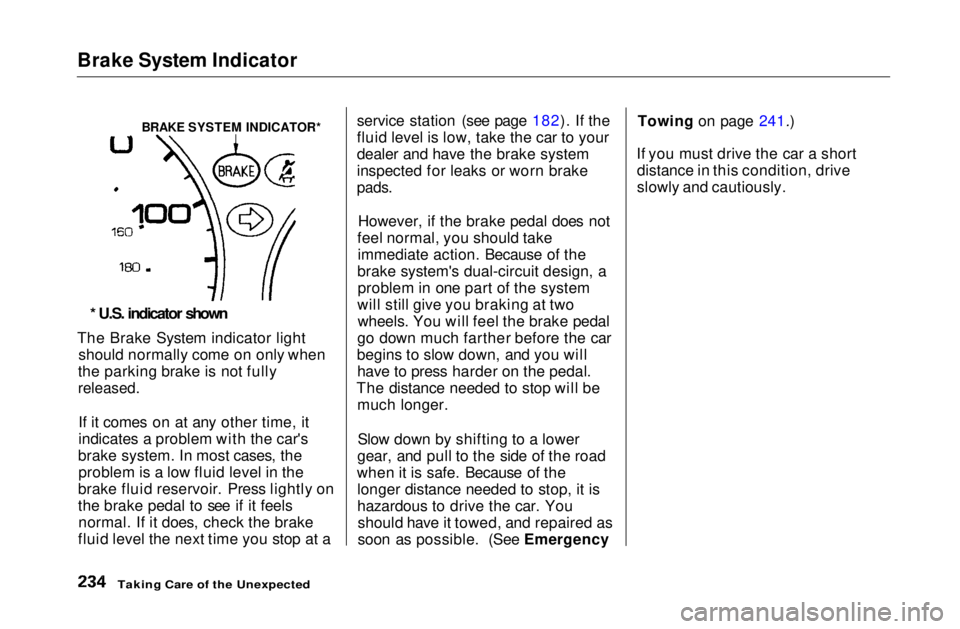
Brake System Indicator
The Brake System indicator light
should normally come on only when
the parking brake is not fully
released.
If it comes on at any other time, it
indicates a problem with the car's
brake system. In most cases, the problem is a low fluid level in the
brake fluid reservoir. Press lightly on
the brake pedal to see if it feels normal. If it does, check the brake
fluid level the next time you stop at a service station (see page 182). If the
fluid level is low, take the car to your
dealer and have the brake system
inspected for leaks or worn brake
pads.
However, if the brake pedal does not
feel normal, you should take immediate action. Because of the
brake system's dual-circuit design, a problem in one part of the system
will still give you braking at two wheels. You will feel the brake pedal
go down much farther before the car
begins to slow down, and you will have to press harder on the pedal.
The distance needed to stop will be much longer.
Slow down by shifting to a lower
gear, and pull to the side of the road
when it is safe. Because of the longer distance needed to stop, it is
hazardous to drive the car. Youshould have it towed, and repaired as
soon as possible. (See Emergency Towing on page 241.)
If you must drive the car a short distance in this condition, drive
slowly and cautiously.
Taking Care of the Unexpected
BRAKE SYSTEM INDICATOR*
* U.S. indicator shownMain Menu Table of Contents s t
Page 266 of 269
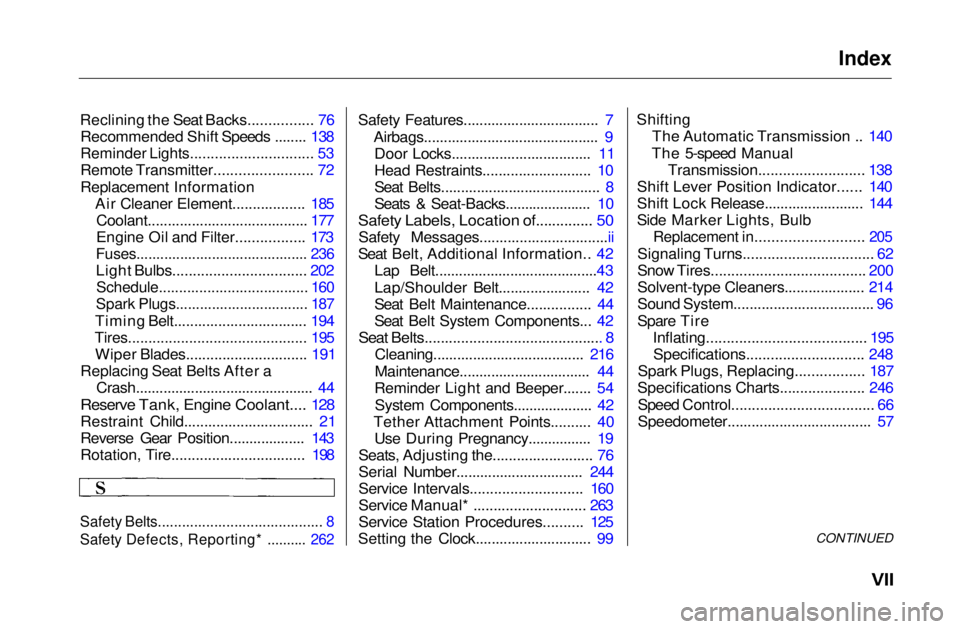
Index
Reclining the Seat Backs................ 76 Recommended Shift Speeds ........ 138
Reminder Lights.............................. 53
Remote Transmitter........................ 72
Replacement Information Air Cleaner Element.................. 185Coolant........................................ 177
Engine Oil and Filter................. 173
Fuses........................................... 236
Light Bulbs................................. 202
Schedule..................................... 160
Spark Plugs................................. 187
Timing Belt................................. 194
Tires............................................ 195
Wiper Blades.............................. 191
Replacing Seat Belts After a Crash............................................. 44
Reserve Tank, Engine Coolant.... 128
Restraint Child................................ 21
Reverse Gear Position................... 143
Rotation, Tire................................. 198
Safety Belts......................................... 8
Safety Defects, Reporting* .......... 262
Safety Features.................................. 7
Airbags............................................ 9Door Locks................................... 11
Head Restraints........................... 10
Seat Belts........................................ 8
Seats & Seat-Backs...................... 10
Safety Labels, Location of.............. 50
Safety Messages................................ii
Seat Belt, Additional Information.. 42 Lap Belt.........................................43
Lap/Shoulder Belt....................... 42
Seat Belt Maintenance................ 44
Seat Belt System Components... 42
Seat Belts............................................ 8
Cleaning...................................... 216
Maintenance................................. 44
Reminder Light and Beeper....... 54
System Components.................... 42
Tether Attachment Points.......... 40 Use During Pregnancy................ 19
Seats, Adjusting the......................... 76
Serial Number................................ 244
Service Intervals............................ 160
Service Manual* ............................ 263
Service Station Procedures.......... 125
Setting the Clock............................. 99 Shifting
The Automatic Transmission .. 140
The 5-speed Manual Transmission.......................... 138
Shift Lever Position Indicator...... 140
Shift Lock Release......................... 144
Side Marker Lights, Bulb
Replacement in.......................... 205
Signaling Turns................................ 62
Snow Tires...................................... 200
Solvent-type Cleaners.................... 214
Sound System................................... 96
Spare Tire Inflating....................................... 195Specifications............................. 248
Spark Plugs, Replacing................. 187
Specifications Charts..................... 246
Speed Control................................... 66
Speedometer.................................... 57
CONTINUEDMain Menu s t
Page 267 of 269
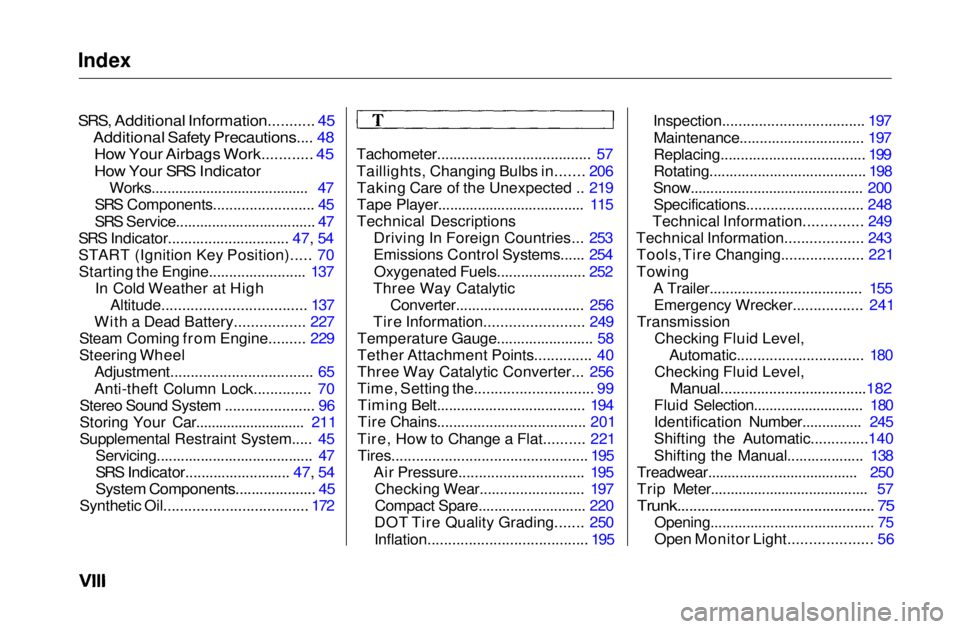
Index
SRS, Additional Information........... 45
Additional Safety Precautions.... 48
How Your Airbags Work............ 45
How Your SRS Indicator
Works........................................ 47
SRS Components......................... 45
SRS Service................................... 47
SRS Indicator.............................. 47, 54
START (Ignition Key Position)..... 70 Starting the Engine........................ 137 In Cold Weather at HighAltitude................................... 137
With a Dead Battery................. 227
Steam Coming from Engine......... 229
Steering Wheel
Adjustment................................... 65
Anti-theft Column Lock.............. 70
Stereo Sound System ...................... 96
Storing Your Car............................ 211
Supplemental Restraint System..... 45 Servicing....................................... 47
SRS Indicator.......................... 47, 54
System Components.................... 45
Synthetic Oil................................... 172 Tachometer...................................... 57
Taillights, Changing Bulbs in....... 206
Taking Care of the Unexpected .. 219
Tape Player..................................... 115
Technical Descriptions Driving In Foreign Countries... 253
Emissions Control Systems...... 254
Oxygenated Fuels...................... 252
Three Way Catalytic Converter................................ 256
Tire Information........................ 249
Temperature Gauge........................ 58
Tether Attachment Points.............. 40
Three Way Catalytic Converter... 256
Time, Setting the............................. 99
Timing Belt..................................... 194
Tire Chains..................................... 201
Tire, How to Change a Flat.......... 221 Tires................................................ 195 Air Pressure............................... 195Checking Wear.......................... 197
Compact Spare........................... 220
DOT Tire Quality Grading....... 250
Inflation....................................... 195 Inspection................................... 197
Maintenance............................... 197
Replacing.................................... 199
Rotating....................................... 198
Snow............................................ 200 Specifications............................. 248
Technical Information.............. 249
Technical Information................... 243 Tools,Tire Changing.................... 221
Towing A Trailer...................................... 155Emergency Wrecker................. 241
Transmission Checking Fluid Level,Automatic............................... 180
Checking Fluid Level,
Manual....................................182
Fluid Selection............................ 180
Identification Number............... 245
Shifting the Automatic..............140
Shifting the Manual................... 138
Treadwear...................................... 250
Trip Meter........................................ 57
Trunk................................................. 75
Opening......................................... 75
Open Monitor Light.................... 56Main Menu s t